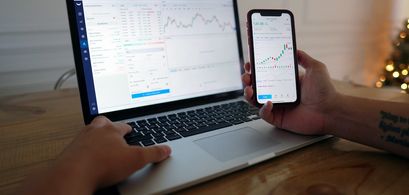Day trading offers a way for anyone to make money off of the markets by leveraging the daily price fluctuations of an asset. Appealing as it may sound, it’s incredibly challenging and not as feasible as everyone thinks.
But given that the internet is packed with materials promising hefty profits with only a day’s work, it’s understandable why anyone would feel tempted to try it. And yet, day trading statistics paint a very different picture.
Read on to find out more about day traders and just how much they stand to lose or gain.
10 Key Day Trading Statistics and Facts
Day traders lost a fantastic $1.14 billion during the pandemic.
A whopping 97% of day traders lose money in less than a year.
A staggering 77% of eToro traders that use CFDs lose money.
An incredible 85% of day traders quit within three years.
Profitable traders account for 12% of all-day trading activities.
A day trader's average return rate is 10%.
There are 9.6 million traders around the globe.
Day traders in the US make around $56.2 an hour.
Sixty percent of day traders are over 40 years old.
Cryptocurrency is the preferred trading choice of younger traders.
Statistics on Day Trading
Day traders lost a fantastic $1.14 billion during the pandemic.
A bonus to this amount is the extra $4.13 billion paid for trading costs.
Between November 2019 and June 2021, the financial toll for short-term options, including trading costs that newbie traders managed to generate, stood at $5 billion, including trading costs.
Moreover, in 2021 when meme stocks like GameStop and AMC experienced considerable spikes in trading volume, inexperienced traders were leveraging over 23 million options contracts a week. A bonus to this amount is the extra $4.13 billion paid for trading costs.
(Bloomberg, SSRN)
A whopping 97% of day traders lose money in less than a year.
Day trading for a living statistics show that only 1.1% of people who started day trading in the Brazilian equity futures market actually managed to earn.
Sadly, their earnings were just slightly higher than Brazil's minimum wage. Another lucky 0.5% managed to make a little more than the initial salary of a bank teller.
In reality, of a total of 1,600 participants in the study, the majority that stuck with trading for at least 300 days reported losing money.
(SSRN)
Less than 1% of day traders consistently profit.
If you look at the above data, successful day trading is nearly impossible. Namely, in a study conducted with over 450,000-day traders on the Taiwan Stock Exchange, half of which traded in amounts of over $20,000 a day, only 4,000 managed to earn money consistently.
Throughout the study, in any given year, about 19% of day traders who traded with over $20,000 a day profited. Another 500 or less than 10% succeeded in generating outsized profits and earned a net of 37.9 bps or 0.379% per day, while the vast majority lost 25-29 bps per day.
(Journal of Financial Markets)
A staggering 76% of eToro traders that use CFDs lose money.
When it comes to day trading facts, one report shows that the reason for such a high percentage of losers is related to ignorance, short-term projections, and making erroneous assumptions that a stock that went up 30% in one year will again do so in the following year.
Regarding CFDs, eToro suggests they are not suitable for long-term investors. Moreover, in the matter of trading CFDs on eToro, it’s a given that 76% of retail investors lose money.
Circling back to the ignorance part, the platform itself advises users to first understand how CFDs work and then decide whether they can risk losing that much money.
(eToro)
The day trading success rate of people earning a living out of it is around 4%.
In absolute numbers, out of 2,000 people that tried day trading, only around 80 had good enough results to make a living. The remaining usually failed, gave up, or left the company, according to reports from experienced traders.
Even though most day traders work six to eight hours a day, Mondays to Fridays, the percentage of those who manage to consistently make some profits but not enough to earn a living ranges between 10% and 15%.
(TradeThatSwing)
An incredible 85% of day traders quit within three years.
Using day trading statistics from the Taiwan Stock Market, a study found that only 15% of day traders survive through the first three years or longer, 44% last a year, and 24% quit within two years.
Only 2.5% of day traders quit within a month. The study also discovered that day traders who perform poorly are most likely to continue trading, despite experiencing losses.
(SSRN)
Profitable traders account for 12% of all-day trading activities.
In other words, day trading success statistics can only be positive if an individual is consistently active. Moreover, an average of 1.6% of day traders are actually profitable in a given year.
Similarly, day traders who have demonstrated strong performance in the past continue to make solid returns in the future.
(Tradeciety)
A day trader's average return rate is 10%.
The rule of thumb is that day traders should strive to keep their win rate at around 50% if they want to be profitable, but only some manage this. In reality, the average day trader's return rate can go as high as 20%, but it all depends on the starting capital.
Other estimates show that, on average, the return of professional day traders ranges from 2% to 6% per day. But this is for those who trade with $10,000.
In comparison, the average return rate for the stock market is lower than that of day traders and stands at 9.8% based on 93 years of data .
(Work - Chron, Chrono Historia)
Day Traders Demographics
There are 9.6 million traders around the globe.
Asia is the motherland of day traders, as 33% of them are concentrated there.
And even though there is no official data on the exact number of day traders in the USA, according to Modern Trader’s report, around 16% are based in North America.
Another 16% are located in Europe, and 14% live in Africa. In addition, 10% live in the Middle East, 6% in South America, and 3% in Central America. Only 2% of traders are based in the Oceania region.
(BrokerNotes)
Successful day traders in the US make around $56.2 an hour.
Based on the above figure, the annual income of a day trader is as high as $116,895. Moreover, day trading trends reveal that the number of jobs in the industry in the US is expected to increase to a staggering 18,500. That’s an increase of 4% by 2028.
Another relevant data for those seeking employment in this niche is that 67.5% of day traders have a bachelor’s degree, 9.9% have a master’s degree, and the rest have a college degree.
However, although most day traders have higher education, it is possible to get a job as a day trader with a high school degree or GED.
(Zippia)
A dominant 90.5% of day traders are men.
If you’re a woman seeking to explore your options in the industry, you should know that the percentage of female day traders is low at 9.5%.
The percentage of women working as day traders has been continuously reducing over the past few years. It was 13.29% in 2017, followed by a drop to 12.67% in 2018, and another one to 11.17% in 2019.
There is also a wide pay gap between genders. On average, male day traders earn around $118,810 a year, while women make approximately 10% less, or $109,405.
Also, on average, women deposit $424 less than men.
(Zippia, BrokerNotes)
60% of day traders are over 40 years old.
In addition, 27% of day traders are between the ages of 30 and 40, and only 13% are 20 to 30 years old, proving that the job is more suited for experienced people.
Day trading employment statistics also show that the size of companies that hire day traders varies significantly. Namely, 45% of companies that hire day traders have 1,000 to 10,000 employees.
17% have between 100 and 500, 14% have 500 to 1,000 employees, and 13% have more than 10,000 employees.
The percentage of companies with less than 50 or up to 100 employees looking to hire day traders is lowest at 10%.
(Zippia)
66.3% of day traders are White.
Another 12.4% are Asian, 11.5% are Hispanic or Latino, 5.5% are African American or Black, and 0.2% are American Indian or Alaska Native, while the remaining 4.1% are of unknown ethnicity.
White day traders profit from trading more than any other race, with an average salary of $115,048. Asian day traders come second with an average annual income of $112,950, and Hispanic and Latino come third with a salary of $105,412 per year.
Black day traders have the lowest day trading income per year of $99,588.
(Zippia)
Cryptocurrency is the preferred trading choice of younger traders.
A recent UK survey found that a massive 75% of traders between the ages of 18 to 34 opt to trade cryptocurrencies.
In addition, the same age group accounts for a total of 65% of all online traders, a percentage that has increased significantly since 2015. More importantly, mobile trading accounts for nearly 60% of all transactions.
(World Finance)
The Summary
Only a fraction of individuals who venture into day trading manage to profit from it consistently. However, although day trading data is presently discouraging, nearly ten million people worldwide are still trading. Moreover, considering job opportunities for day traders in the US are expected to grow, stats might take a turn for the better in the future.
Day Trading FAQ
How much does the average day trader make?
What percentage of day traders fail?
Is it possible to live off day trading?
Sources:


.jpg)



